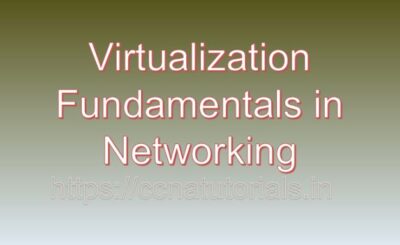Contents of this article
In this article I describe the On Premise Networking concepts for ccna. I can give you an overview of On Premise Networking concepts for ccna, along with examples.
On Premise networking concepts refers to the deployment and management of networking infrastructure within an organization’s physical premises, such as data centers, offices, or facilities. In an On Premise networking setup, organizations own and maintain the networking hardware, software, and resources required to support their network infrastructure. This includes routers, switches, firewalls, servers, storage devices, and other networking equipment installed and operated on-site.
Example of On Premise Networking concepts for ccna:
An example of On Premise networking is a company that maintains its own data center to host servers, storage systems, and networking equipment for internal use. The company’s IT team is responsible for managing and maintaining the network infrastructure, configuring routers and switches, setting up firewalls, and ensuring network security and performance.
Cloud Networking:
Cloud networking refers to the use of cloud-based services and resources to support network infrastructure and operations. In a cloud networking model, organizations leverage cloud service providers (CSPs) to host, manage, and deliver networking services and capabilities over the internet. Cloud networking enables organizations to offload the management and maintenance of networking infrastructure to third-party providers, accessing scalable and flexible network resources on-demand.
Example:
An example of cloud networking is a company that migrates its servers and applications to a public cloud platform such as Amazon Web Services (AWS), Microsoft Azure, or Google Cloud Platform (GCP). The company leverages cloud-based networking services such as virtual networks, load balancers, VPN gateways, and content delivery networks (CDNs) to support its network infrastructure. By utilizing cloud networking services, the company gains agility, scalability, and cost-efficiency, while reducing the burden of managing On Premise networking hardware and resources.
Differences between On Premise Networking and cloud computing:
Ownership and Control:
- On Premise Networking: Organizations own and have full control over their networking hardware and resources, allowing them to customize and manage the infrastructure according to their specific requirements.
- Cloud Networking: Cloud networking relies on third-party cloud service providers, which own and manage the networking infrastructure on behalf of organizations. Organizations have limited control over the underlying hardware and resources, instead relying on the CSPs to deliver network services.
Infrastructure Location:
- On Premise Networking: Networking infrastructure is physically located within the organization’s premises, typically in data centers or office facilities owned or leased by the organization.
- Cloud Networking: Networking infrastructure is hosted and maintained in remote data centers operated by cloud service providers, accessible to organizations over the internet.
Scalability and Flexibility:
- On Premise Networking: Scaling On Premise networking infrastructure requires purchasing and provisioning additional hardware and resources, which can be time-consuming and costly.
- Cloud Networking: Cloud networking offers scalability and flexibility, allowing organizations to rapidly provision and scale network resources on-demand, based on changing requirements and workloads.
Maintenance and Management:
- On Premise Networking: Organizations are responsible for the maintenance, management, and troubleshooting of their On Premise networking infrastructure, including hardware upgrades, software updates, and security patches.
- Cloud Networking: Cloud service providers handle the maintenance, management, and monitoring of the networking infrastructure, reducing the administrative burden on organizations. CSPs also provide automated tools and services for network configuration, monitoring, and optimization.
Conclusion for On Premise Networking concepts for ccna
In summary, On Premise Networking concepts involves deploying and managing networking infrastructure within an organization’s physical premises, while cloud networking leverages cloud-based services and resources provided by third-party providers. Each approach offers unique advantages and considerations, and organizations may choose to adopt a hybrid approach that combines elements of both On Premise and cloud networking to meet their specific needs and objectives.
I hope you found this article helpful related to On Premise Networking concepts for ccna. You may drop a comment below or contact us for any query or suggestions related to the contents of this website.






